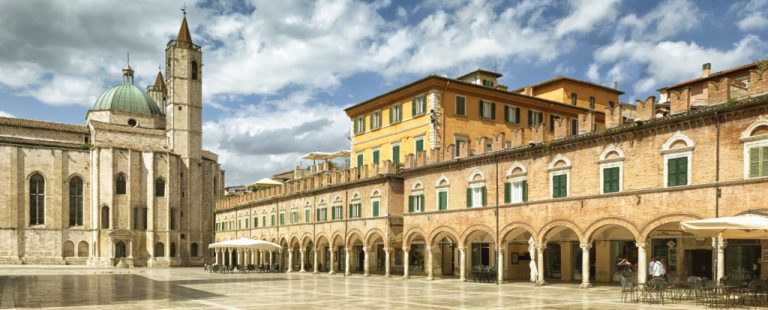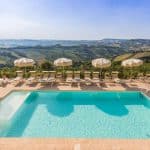The province of Ascoli Piceno – the southernmost province in the Marche region – is a wonderful area, nestled between the mountains of the Sibillini National Park and the splendid beaches of the Riviera delle Palme. This territory presents not only breathtaking natural beauty, but also splendid towns and villages rich in history and culture, and an incomparable food and wine.
So, here is what to see absolutely in the province of Ascoli Piceno, to spend an unforgettable holiday from your holiday home in Ascoli Piceno:
1. Montefiore dell’Aso
Included in the list of the Most Beautiful Villages in Italy, Montefiore dell’Aso lies among the green hills of the Marche countryside, a few kilometres from the coast.
Montefiore is a village of incomparable charm, with many places of interest to visit in a day. First and foremost, the town’s imposing walls, which immediately strike the visitor for their excellent preservation. This wall once protected the town’s two castles and its six towers.
Another building of historical and cultural (as well as religious) interest is the Church of San Francesco, and the convent with the same name. This building, first erected in 1303, has been restored numerous times over the course of time, until it took on a predominantly Baroque style, compared to the original Romanesque-Gothic. Inside, it features a grandiose marble funeral monument in honour of the parents of Cardinal Gentile Partino from 1310, the tomb of the painter Adolfo De Carolis and numerous frescos. The monastery, on the other hand, has numerous rooms dedicated to art, the most interesting of which is undoubtedly the hall of rural civilisation, which displays objects and tools used by the local rural population.
Another important religious building is the Church of Santa Lucia, built between the 3rd and 5th centuries and later restored in neoclassical style. Its façade is marvellous, where we find the doorway of the Mother Church, made of stone blocks, and where there are early Christian symbols from the 11th-12th centuries.
But, of course, the main attraction of this village is simply to walk through the narrow streets and lanes of the town, and to reach points of interest such as Piazza della Repubblica – home to a number of significant buildings such as the ancient collegiate church of Santa Lucia, the Town Hall and the Clock Tower – and up to the Aspromonte Gate. From here you can reach the Belvedere Adolfo de Carolis, a beautiful panoramic terrace overlooking the Sibillini Mountains, the Gran Sasso and Monte Vettore.
2. Cupra Marittima
Overlooking the sea and nestled among the green hills of the Marche region, the beautiful town of Cupra Marittima is part of the famous ‘Riviera of the Palms’ and proudly sports the Blue Flag, an award given to coastal towns for the quality of their beaches.
The town of Cupra Marittima, in particular, is truly a little gem and the visitor will be amazed by the sheer number of its attractions and their beauty.
First place to visit are, of course, the beaches of Cupra, consisting of long sandy shores, a crystal clear sea with a gently sloping seabed, and a wide range of facilities. All this makes the beaches of Cupra a truly perfect place to relax and enjoy a beautiful sunny day, perhaps taking a walk along the coast or – for the more active – practising some sport, such as windsurfing.
However, it is not only the beaches that are the attraction of this beautiful village: just above the beaches of Cupra Marittima is the ancient town, perched on the hill above the beach, which is definitely worth a visit for its romantic narrow streets and the magnificent view of the Adriatic Sea
Moreover, for all culture enthusiasts, Cupra Marittima is also home to several museums, such as the very interesting Malacological Exhibition “Shells from around the world” and the Territorial Archaeological Museum, which houses some prehistoric finds from the Piceno civilisation.
Another centre of cultural interest is the Cupra Marittima archaeological park, characterised by a few visible but interesting structures that give an idea of the richness and vitality of the area.
For example, the remains of the Augustan walls, within which we can see the remains of a number of sacred buildings and the sanctuary of the goddess Cupra, an indigenous divinity similar to Juno in the Roman pantheon, whose name is strongly associated with the town and dates back to the Picenum period.
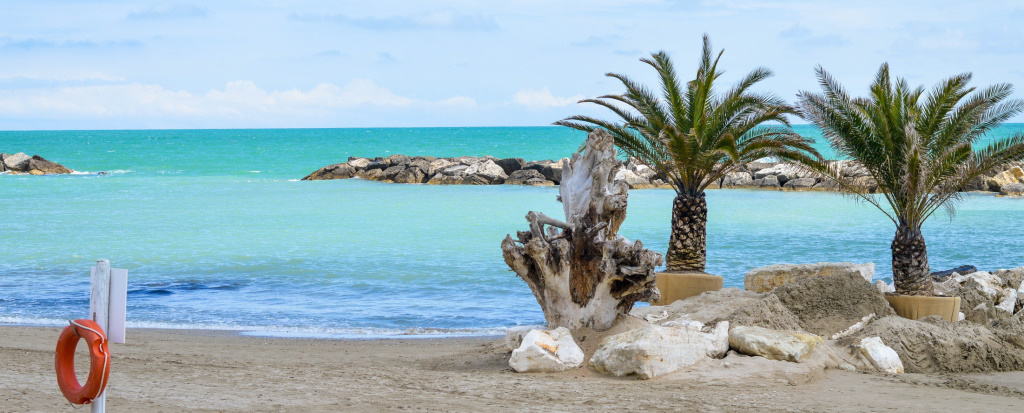
Beach in Cupra Marittima
3. San Benedetto del Tronto
San Benedetto del Tronto is a charming town with a strong marine tradition in the province of Ascoli Piceno, and is part of the famous Riviera delle Palme. The town has countless wonders to discover, from its beautiful beaches and sea, to the many interesting museums and historical remains, to the culinary tradition of brodetto alla sanbenedettese.
Obviously, the first stop on a visit to San Benedetto is to its beautiful beaches of fine, golden sand, which stretch for kilometres. Visitors can walk along its beautiful, well-kept promenade, lined with cycle paths, tennis courts, skating rinks, pinewoods and, above all, a huge variety of palm trees.
The promenade is also lined with incredible works of art for which San Benedetto is particularly famous: from the monument dedicated to the seagull Jonathan Livingston – the protagonist of Richard Bach’s unforgettable book – to the marvellous sculptures created by artists from all over the world, who have created a veritable open-air museum.
Moreover, to continue the cultural and historical visit of San Benedetto, you cannot miss a visit to the historical centre of the town, the original ancient village called “Paese Alto”, characterised by the hexagonal Gualtieri Tower dating back to 1300, rich in brackets and battlements.
A lunch based on San Benedetto’s gastronomic specialities is certainly not to be missed, featuring a long series of fish recipes ranging from fried fish to marinated anchovies to the undisputed king, brodetto alla sambenedettese. Nowadays, the latter comes in many different versions, but they all convey that strong feeling of the sea.
4. Ripatransone
Ripatransone, also known as ‘Il Belvedere del Piceno’ (Piceno’s viewpoint) because of its magnificent panoramic view, is one of the most charming villages in the province of Ascoli Piceno, and has many attractions to visit.
The village has medieval origins, with numerous points of interest in its historic centre and a strategic position that allows visitors to look out over the beautiful landscape, that spaces between Abruzzo and the Adriatic Sea.
There are numerous attractions to admire in Ripatransone, one of which is certainly its historic centre. Considered to be one of the oldest and most important centres in the province, the historic centre of Ripatransone is typically medieval, with numerous narrow streets and alleyways that are incredibly fascinating. Here we can also find the narrowest alley in Italy, that is no more than 43 centimetres wide!
In the heart of Ripatransone we find Piazza Matteotti, with its elegant lodges and wood columns in Venetian style, and where we can also find the 18th century Palazzo Massi Mauri and Casa Teodori-Maroni. Near the historical centre there are also many churches, such as the Cathedral in honour of Saints Gregory the Great and Margaret, designed at the end of the 16th century, and the Church of St. Augustine dating back to the 15th-18th century, deconsecrated, and currently housing the Bishop’s Museum.
Other places definitely worth a visit in Ripatransone are the beautiful staircase in Via Margherita, and the Luigi Mecantini Theatre, opened in 1824 and featuring a finely decorated auditorium and a beautiful historical curtain, dated 1870.
But Ripatransone is not only a place where you can admire churches and historical beauties: this is a land renowned for its great food and wine, and one of the best attractions is to enter in one of the many small restaurants in the village and taste the typical local dish, the ciavarro.
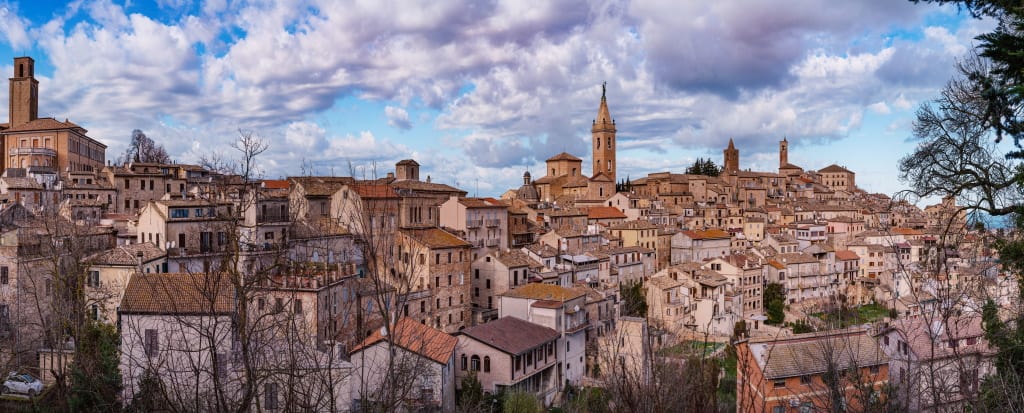
View of Ripatransone
5. Montedinove and Rotella
Among the many beautiful villages in the province of Ascoli Piceno, two in particular are definitely worth a visit: the villages of Montedinove and Rotella.
The medieval village of Montedinove stands on the highest peak of a chain of hills in the Marche region, and offers a view that spans from the Adriatic coast to the Sibillini Mountains. Montedinove is a village of medieval origins, which still retains part of its original walls and unravels through narrow streets that are impossible not to be fascinated by.
The buildings, the streets and the ruins of ancient constructions tell of the past of the village of Montedinove. This past is quite evident in the remains of fortifications such as the ‘Gate of Victory’, built in the 12th century, and the ruins of the medieval tower also dating from the same historical period. Moreover, walking through the old town centre, one is fascinated by the beauty of the architecture, such as the municipal wash houses, the fountains of the Polesio aqueduct, the coat of arms of the congregation of ‘sutores’ (tailors) from the 14th century and the characteristic and elegant lodges from the 15th century.
Another particularly interesting village to visit is Rotella, a characteristic hamlet in the Piceno inland, which stands on the slopes of Mount Ascensione.
The most well-known symbol of Rotella is the Civic Clock Tower, an ancient bell tower dating back to the 15th century, and a must-see for lovers of history and culture. Rotella also has a number of prestigious churches, such as the Collegiate Church of SS. Maria and Lorenzo, which dates back to 1767, and the Church of Santa Viviana or of the Icons.
However, these villages are not only known for their cultural heritage, but also for their delicious typical dishes – such as chestnut ravioli in Rotella or the famous red apple of the Sibillini Mountains in Montedinove, which is used to cook many sweet and savoury recipes – and the many typical festivals throughout the year.
6. Ascoli Piceno
Ascoli Piceno, the capital of this province in the south of Le Marche, is also known as the “city of 100 towers” because of countless towers that are located in the city. The most famous of these is Torre degli Ercolani or Palazzetto Longobardo, but by following the specific “route of the towers”, it will also be possible to admire the Twin Towers, and then end up in Piazza Ventidio Basso.
Speaking of squares, one of the city’s highlights is undoubtedly Piazza del Popolo, considered one of the most beautiful squares in Italy, thanks to its paving made entirely of travertine, making the square look strikingly harmonious and elegant.
Piazza del Popolo is surely the centre of Ascoli, an obligatory point of passage for tourists and citizens, who meet here for the ritual of coffee or an aperitif. Why not do the same, and have a nice coffee in the historic Caffè Meletti, which overlooks this very square? This beautiful café is one of Italy’s 150 historic cafés, and since 1905 has been a meeting place for painters, writers, entrepreneurs and ordinary people.
There are numerous attractions to see in Ascoli, in addition to those already mentioned, including: the beautiful Piazza Arrigo, which competes with Piazza del Popolo for the role of civil and religious centre of Ascoli, and where are located the Diocesan Museum and the Pinacoteca Civica. The latter – in particular – houses works by the artist Carlo Crivelli, a Venetian master from the 1400s.
Lastly, how could we not mention Ascoli’s cuisine, which includes many tasty dishes, such as the famous Ascoli Olives? They are Ascoli’s most representative dish and they require products, time and effort to prepare: all this for that brief moment of ecstasy, but it is absolutely worth it!
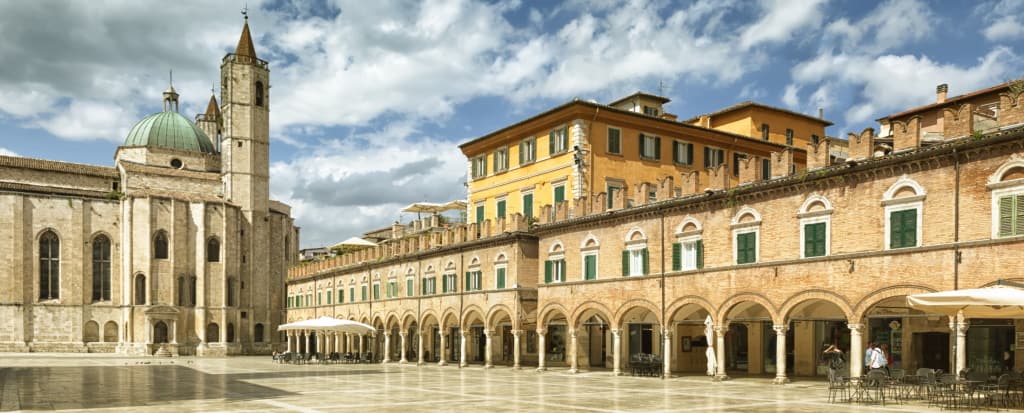
Piazza del popolo’s square in Ascoli Piceno
7. Offidia
A magnificent village rich in history and traditions, Offida overlooks the beautiful hills of the Marche region, exactly halfway between Ascoli Piceno and the sea.
This village can surprise visitors with its beauty and numerous points of interest to visit: first and foremost, the marvellous church of Santa Maria della Rocca which, perched on a mountain ridge, towers over the entire Marche region. The crypt of the church contains part of the frescoes, attributed to the Master of Offida, depicting the cycles of St Catherine of Alexandria, St Lucy and various other Saints and Virgins on the throne. The upper church also has traces of frescoes that once completely covered the walls.
There are also some very interesting museums in Offida that are definitely worth a visit, such as the Archaeological Museum, which houses the fundamental nucleus of the “Lithic Workshop” of the two important Picenes necropolises of Offida and Spinetoli, and the Museum of Popular Traditions, which offers, among other things, the faithful reconstruction of one of the ancient kitchens of the building once present in the village.
There is also the Lace Museum, which also exhibits a dress worn by Naomi Campbell.
Finally, Offida is known throughout Italy for its wines, and in particular for its Rosso, Pecorino and Passerina, suitable for accompanying both sweet and savoury dishes.
8. Grottammare
Grottammare, also known as the ‘Pearl of the Adriatic‘, is a beautiful town where the sea, good food, art, history and culture intertwine.
This beautiful town is part of the so-called Riviera delle Palme, and has many attractions that makes it an unmissable destination, worth visiting at least once in a lifetime.
Of course, this town is best known for its beautiful beaches with fine sand and crystal clear water, with a safe and shallow seabed that makes them very popular with families.
The beaches are also renowned for the quality of their services, and for the many leisure opportunities they offer: among these, for example, is the beautiful Riviera delle Palme cycling path that connects Grottammare with Cupra Marittima and San Benedetto del Tronto, for a total length of about 8 km. The visitor can therefore rent a bike and cycle all over the Riviera delle Palme without rush, only stopping occasionally at the beautiful beaches along the way.
The actual centre of Grottammare lies at the foot of Monte Castello: here we find the medieval part of the town, which develops around Piazza Peretti, overlooked by the Palazzo Priorale, the Altana dell’Orologio, Teatro dell’Arancio, the elegant lodge and the splendid panoramic viewpoint.
There are also several churches in the city that are definitely worth a visit: these include the Church of San Giovanni il Battista, a 14th-century church that was almost completely rebuilt in 1802, and the Church of Santa Lucia, built in the 16th century at the behest of Camilla Peretti, in memory of her brother Felice, known as Pope Sixtus V.
There are also many other attractions to admire in this beautiful city, such as numerous other churches, the Monte Castello Park or just the beautiful narrow streets and medieval lanes in the city centre.
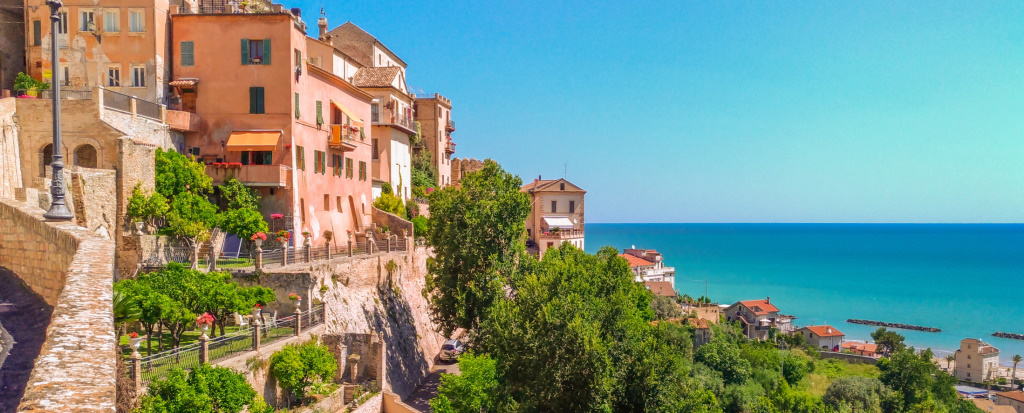
View of Grottamare
9. Acquasanta Picena
The small municipality of Acquasanta Terme is located in the province of Ascoli Piceno, and is set in a special natural context, characterised by hills and surrounded by the mountains of the Gran Sasso e Monti della Laga National Park and the Sibillini Mountains.
As is clear from its name, the village of Acquasanta Terme is mainly known for its precious thermal waters, which have been used since Roman times. It seems that numerous historical figures such as Charlemagne visited and benefited from the precious thermal springs.
Nowadays many tourists visit Acquasanta to undergo thermal cures, which today are administered in modern facilities equipped with swimming pools, beauty centre, wellness centre and much more. Moreover, within the territory of Acquasanta, there is also the thermal spring ‘Lu vurghe’, where visitors can benefit from its healthy waters completely free of charge.
Acquasanta also has some interesting cultural sites, such as Castel di Luco, built in the 14th century and located a short distance from the town, on the edge of a rocky spur. Speaking of historical works, there are even some Roman remains in the vicinity of the town, such as the Roman retaining walls of the Salaria from the Augustan period, which can be found in the hamlet of Ponte d’Arli.
Acquasanta, however, is not just about culture and relaxation: at different periods during the year a number of different traditional festivals take place in the area, such as the historic Piceno Carnival and the Autumn Festival, among many others.
10. Monteprandone
Monteprandone is a medieval village in the province of Ascoli Piceno, surrounded by the green countryside of southern Marche.
The village still has a rich historical and artistic heritage linked to its past, such as part of the 14th-15th century town walls and the medieval gate Borgo da Monte. There are also numerous historic churches worth visiting, such as the very ancient Church of San Niccolò and the 15th-century Church of Santa Maria delle Grazie.
Another religious building of great importance is the Franciscan monastery complex, built in 1449 by San Giacomo della Marca. In this building there is a museum where you can admire objects related to the life of the saint. There are also a number of perfectly preserved manuscripts that are part of the Liberia di San Giacomo, a collection of writings dating back to the 15th century.
Furthermore, nature lovers should not miss the half-day excursion to the Sentina Regional Nature Reserve, located at the mouth of the Tronto River. This incredible area is rich in natural beauty, and offers the possibility of hiking or cycling, or birdwatching for the most passionate.
11. Cossignano
Cossignano, a small municipality in the Province of Ascoli Piceno, embodies the typical stereotype of a small town far from the hustle and bustle of city life and mass tourism, although there is more than one reason why this village is worth a visit.
First and foremost, its panoramic position: its historic centre, in fact, is perched on the top of a hill from which you can admire the magnificent landscape of the Marche region, an alternation of olive groves and gullies separated on the horizon by the profile of the Sibillini Mountains and the unmistakable outline of Mount Vettore.
The village of Cossignano is surrounded, like many of the small villages in the Marche region, by walls dating back to the 13th century, with the Porta di San Giorgio, the oldest part of the walls.
Strolling through the old town centre, a visit to the Palazzo Comunale is a must. Inside there is a painting of St George and a couple of relics including a red shirt worn by one of the thousand brave men who followed Giuseppe Garibaldi and a 1303 bell with the coat of arms of Cossignano.
Another place absolutely worth visiting in Cossignano is the Church of the Annunziata, built around 1265, and full of incredible frescoes, while on the upper floor you can admire a recently restored mid-19th century organ.
In addition to the artistic beauties, it is also particularly interesting to simply walk through the streets of the village and admire the small alleyways, the medieval walls and, above all, the so-called ‘porte del morto‘ (dead man’s gates), i.e. gates that were once opened and consequently walled up in medieval times to let the coffins of the dead out of the houses.
12. National park of the Sibillini mountains
There is so much to say about the Sibillini Mountains and their natural park: this beautiful area, which straddles the Marche and Umbria regions and stretches across several provinces, is full of wonders and offers visitors the chance to experience truly wonderful routes in the presence of absolutely incredible nature.
The Sibillini mountains are made up of calcareous rocks, and their peaks often exceed 2,000 metres: for example, Monte Vettore, at 2,478 metres is considered the highest peak in the chain.
The Sibillini mountains offer some truly unique places of beauty, such as the spectacular Lago di Pilato. Set among the mountains and located at an altitude of 1,941 metres, this lake appears to be something out of a fairy tale, with its cobalt blue colour and high mountains surrounding it.
The routes to this wonderland are not the easiest, but for trekking enthusiasts and the more daring, the effort will be well rewarded by the views that can be enjoyed during the excursion.
There are many other places to visit in the Sibillini Mountains, from the wonderful Hermitage of San Leonardo, to the plains near Castelluccio di Norcia, where, in spring, blankets of colourful flowers spread out.
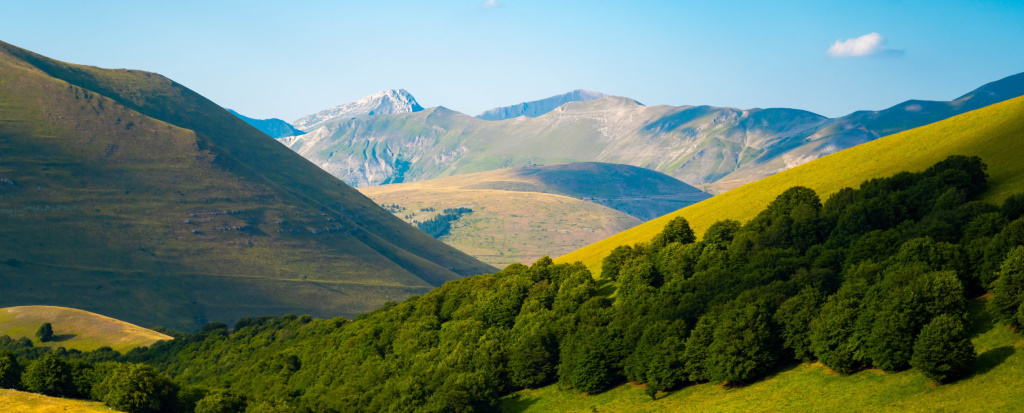
Monti Sibillini Italian national park in Marche region, beautiful natural landscapes in Castelluccio di Norcia
